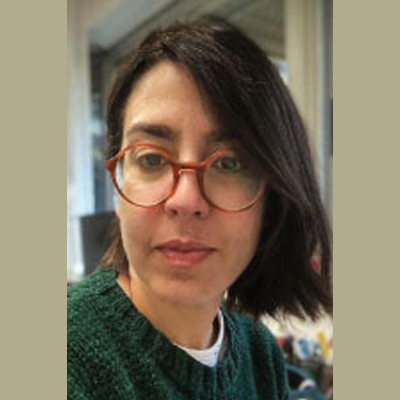Natalia Riva
Pharmacometrics and Systems Pharmacology
Department of Pharmaceutical Technology and Chemistry
School of Pharmacy and Nutrition
University of Navarra
Pamplona, Spain
There has been a long-time oversight on my part that we have not heard from our Compass chief editor, Natalia Riva, in our blog series. This month we are correcting that, and we hear from ‘our’ Nata, whose hard work is known to members, and who has recently been undertaking a post-doc with a Pharmacometrics and Systems Pharmacology group in Pamplona, Spain. It is wonderful that this progression builds on her long-term work with Innovative Therapies group at the pediatric hospital JP Garrahan, Buenos Aires, with which she continues to collaborate. Nata has had a wonderful career and I’m sure we will see many more impressive achievements from this bright Young Scientist.
Can you tell us a little bit about your respective roles? What is a typical day like for you?
I am a pharmacist currently doing my post-doc research in pharmacometrics at Pharmacometrics and Systems Pharmacology, Department of Pharmaceutical Technology and Chemistry, School of Pharmacy and Nutrition, University of Navarra, Pamplona (Navarra, Spain). This position allows me to continue collaborating as a researcher of the National Organization for Research and Tech Development (CONICET) with Garrahan Pediatric Hospital, Buenos Aires, Argentina, by conducting previous and new studies under the direction of Paula Schaiquevich.
My current line of research involves immunosuppressive schemes in pediatric transplantation, off-label use of biological drugs (and biosimilars) in complex pediatric diseases and systems pharmacology/PKPD models supporting drug development of innovative anti-viral therapeutics, integrating the complex interactions between the viral dynamics and the host immune system.
It’s been a year since I moved to Pamplona and changed from the hospital environment to an academic one. This opportunity is increasing my training in R and different software (Simulx, Matlab/ Simbiology/ NONMEM), and pushing my patience to another level! ????
Population modelling takes a large part of the day, and it would be impossible to make progress without the support of my colleagues. Fortunately, no two days are the same: I write reports, I make presentations to the HBV team, I guide a graduate student, I take courses, and I participate in teaching activities such as the annual Summer Course, offered for free.
Is there anything that is done at your centre that you would consider innovative?
Although the evaluation of the performance of biosimilars through intensive pharmacovigilance may not be innovative, the evaluation of their off-label use in pediatrics, in addition to the subsequent population PKPD/KPD (kinetic pharmacodynamic) modelling approach, is definitively relevant and necessary in daily practice.
The training and collaboration with the Pharmacometrics and Systems Pharmacology group from Navarra, and the integration of experimental and in silico approaches to inform therapeutic use (through different computer tools with the state-of-the-art experimental approaches) is the main driving force to progress in science and translation into clinical practice.
In transplantation and immunosuppression, there has been a recent shift in thinking that the liver is not an immunogenic organ. The work we started 10 years ago in pediatric liver transplantation at Garrahan Pediatric Hospital is now leading to a new approach centred on novel biomarkers and risk-stratification, considering donor and recipient molecular HLA mismatches, development of donor-specific antibodies, and donor-derived cell free DNA as a biomarker of graft injury, are definitively highly innovative approaches. This research combined with population PKPD modelling may result in clear benefits in attaining individualized therapy.
What technological innovations have entered into use during your career that have permitted a change, or evolution, in practice?
The development of molecular methodologies for both research and clinical use (i.e. to evaluate graft health, quantification of intracellular viral biomarkers) have dramatically increased during my career. In addition, free and user-friendly software, accessibility and open courses/lectures (especially during the pandemic) have led me to realise time is the most finite resource.
How did you become interested in TDM/ClinTox/your area of expertise?
Working in the area of transplantation at Garrahan Pediatric Hospital, I learned about the relevance of PKPD. I could directly see how much inter/intraindividual variability in drug exposure led to toxicity and poor outcomes. I instantly decided I wanted to help based on what I could do with my work and knowledge. This made me keen on TDM, and lately, pharmacometrics.
It was definitively a turning point in my career, when an IATDMCT satellite symposium in 2012 was developed in Buenos Aires where Prof. van Gelder was invited as speaker. Paula introduced me to him, and we talked about the possibility of doing a research visit to Rotterdam, supported by the Argentinian reserach funding body, CONICET. That experience changed my professional life forever. I met Dennis Hesselink, Brenda de Winter, Louise Andrews, Birgit Koch and all the team at Erasmus MC. Pharmacometrics appeared in my skill set, and my intentions to learn and feed this knowledge back to the clinic strengthened.
What sort of research do you have on the horizon that you think might influence clinical practice in the future?
Clinical practice will be optimized when communication between stakeholders improves. Shiny apps, for instance are a good way to achieve a friendly communication. Communication and collaboration between hospital and academia is a must.
What do you consider is the future for TDM and CT? What are you excited about? What are the challenges we face?
From my point of view, the future is translation of population PK/PD models into the clinics and direct impact of patient care using novel biomarkers and appropriate risk stratification. I am excited about developing adequate models that may be used as a tool to support decision making in clinical practice.
The content of the IATDMCT Blog does not necessarily have the endorsement of the Association.



